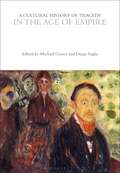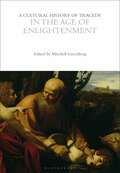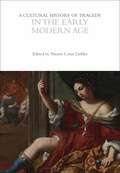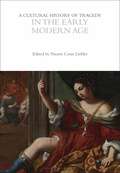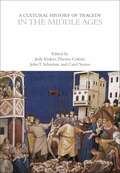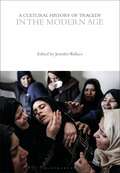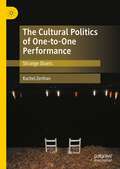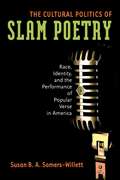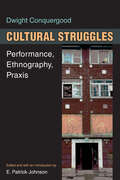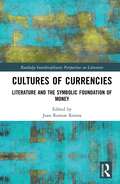- Table View
- List View
A Cultural History of Tragedy in the Age of Empire (The Cultural Histories Series)
by Michael Gamer and Diego SagliaThis volume traces a path across the metamorphoses of tragedy and the tragic in Western cultures during the bourgeois age of nations, revolutions, and empires, roughly delimited by the French Revolution and the First World War. Its starting point is the recognition that tragedy did not die with Romanticism, as George Steiner famously argued over half a century ago, but rather mutated and dispersed, converging into a variety of unstable, productive forms both on the stage and off. In turn, the tragic as a concept and mode transformed itself under the pressure of multiple social, historical and political-ideological phenomena. This volume therefore deploys a narrative centred on hybridization extending across media, genres, demographics, faiths both religious and secular, and national boundaries. The essays also tell a story of how tragedy and the tragic offered multiple means of capturing the increasingly fragmented perception of reality and history that emerged in the 19th century.Each chapter takes a different theme as its focus: forms and media; sites of performance and circulation; communities of production and consumption; philosophy and social theory; religion, ritual and myth; politics of city and nation; society and family, and gender and sexuality.
A Cultural History of Tragedy in the Age of Empire (The Cultural Histories Series)
This volume traces a path across the metamorphoses of tragedy and the tragic in Western cultures during the bourgeois age of nations, revolutions, and empires, roughly delimited by the French Revolution and the First World War. Its starting point is the recognition that tragedy did not die with Romanticism, as George Steiner famously argued over half a century ago, but rather mutated and dispersed, converging into a variety of unstable, productive forms both on the stage and off. In turn, the tragic as a concept and mode transformed itself under the pressure of multiple social, historical and political-ideological phenomena. This volume therefore deploys a narrative centred on hybridization extending across media, genres, demographics, faiths both religious and secular, and national boundaries. The essays also tell a story of how tragedy and the tragic offered multiple means of capturing the increasingly fragmented perception of reality and history that emerged in the 19th century.Each chapter takes a different theme as its focus: forms and media; sites of performance and circulation; communities of production and consumption; philosophy and social theory; religion, ritual and myth; politics of city and nation; society and family, and gender and sexuality.
A Cultural History of Tragedy in the Age of Enlightenment (The Cultural Histories Series)
by Edited by Mitchell GreenbergThe period covered by this volume in the Cultural History of Tragedy set is bookended by two shockingly similar historical events: the beheading of a king, Charles I of England in 1649 and Louis XIV of France in 1793. The period between these two dates saw enormous political, social and economic changes that altered European society's cultural life. Tragedy, which had dominated the European stage at the beginning of this period, gradually saw itself replaced by new literary forms, culminating in the gradual decline of theatrical tragedy from the heights it had reached in the 1660s. The dominance of France's military and cultural prestige during this period is reflected in the important, almost exclusive, space dedicated in this volume to the French stage. This book covers the tragedies of France's two greatest playwrights - Pierre Corneille (1606-84) and Jean Racine (1639-99) - which would dominate not only the French stage but, through translations and adaptations, became the model of tragic theater across Europe, finding imitators in England (Dryden), Italy (Alfieri) and as far afield as Russia. This dominance continued well into the 18th century with the triumph of Voltaire's tragedies. This volume also examines how the writings of Diderot and Lessing changed the direction of theatre and how after the Revolution, in the writings of Goethe, Shiller, Hegel, tragedy and the tragic were reimagined and became the sign of European modernity.Each chapter takes a different theme as its focus: forms and media; sites of performance and circulation; communities of production and consumption; philosophy and social theory; religion, ritual and myth; politics of city and nation; society and family, and gender and sexuality.
A Cultural History of Tragedy in the Early Modern Age (The Cultural Histories Series)
by Edited by Naomi Conn LieblerIn this volume, 8 lively, original essays by eminent scholars trace the kaleidoscopically shifting dramatic forms, performance contexts, and social implications of tragedy throughout the period and across geographic, political, and social references. They attend not only to the familiar cultural lenses of English and mainstream Continental dramas but also to less familiar European exempla from Croatia and Hungary.Each chapter takes a different theme as its focus: forms and media; sites of performance and circulation; communities of production and consumption; philosophy and social theory; religion, ritual and myth; politics of city and nation; society and family, and gender and sexuality.
A Cultural History of Tragedy in the Early Modern Age (The Cultural Histories Series)
In this volume, 8 lively, original essays by eminent scholars trace the kaleidoscopically shifting dramatic forms, performance contexts, and social implications of tragedy throughout the period and across geographic, political, and social references. They attend not only to the familiar cultural lenses of English and mainstream Continental dramas but also to less familiar European exempla from Croatia and Hungary.Each chapter takes a different theme as its focus: forms and media; sites of performance and circulation; communities of production and consumption; philosophy and social theory; religion, ritual and myth; politics of city and nation; society and family, and gender and sexuality.
A Cultural History of Tragedy in the Middle Ages (The Cultural Histories Series)
by Jody Enders, Theresa Coletti, John T. Sebastian, and Carol SymesFor the first time, a group of distinguished authors come together to provide an authoritative exploration of the cultural history of tragedy in the Middle Ages. Reports of the so-called death of medieval tragedy, they argue, have been greatly exaggerated; and, for the Middle Ages, the stakes couldn't be higher. Eight essays offer a blueprint for future study as they take up the extensive but much-neglected medieval engagement with tragic genres, modes, and performances from the vantage points of gender, politics, theology, history, social theory, anthropology, philosophy, economics, and media studies. The result? A recuperated medieval tragedy that is as much a branch of literature as it is of theology, politics, law, or ethics and which, at long last, rejoins the millennium-long conversation about one of the world's most enduring art forms.Each chapter takes a different theme as its focus: forms and media; sites of performance and circulation; communities of production and consumption; philosophy and social theory; religion, ritual and myth; politics of city and nation; society and family, and gender and sexuality.
A Cultural History of Tragedy in the Middle Ages (The Cultural Histories Series)
For the first time, a group of distinguished authors come together to provide an authoritative exploration of the cultural history of tragedy in the Middle Ages. Reports of the so-called death of medieval tragedy, they argue, have been greatly exaggerated; and, for the Middle Ages, the stakes couldn't be higher. Eight essays offer a blueprint for future study as they take up the extensive but much-neglected medieval engagement with tragic genres, modes, and performances from the vantage points of gender, politics, theology, history, social theory, anthropology, philosophy, economics, and media studies. The result? A recuperated medieval tragedy that is as much a branch of literature as it is of theology, politics, law, or ethics and which, at long last, rejoins the millennium-long conversation about one of the world's most enduring art forms.Each chapter takes a different theme as its focus: forms and media; sites of performance and circulation; communities of production and consumption; philosophy and social theory; religion, ritual and myth; politics of city and nation; society and family, and gender and sexuality.
A Cultural History of Tragedy in the Modern Age (The Cultural Histories Series)
by Jennifer WallaceIn this book leading scholars come together to provide a comprehensive, wide-ranging overview of tragedy in theatre and other media from 1920 to the present. The 20th century is often considered to have witnessed the death of tragedy as a theatrical genre, but it was marked by many tragic events and historical catastrophes, from two world wars and genocide to the proliferation of nuclear weapons and the anticipation and onset of climate change. The authors in this volume wrestle with this paradox and consider the degree to which the definitions, forms and media of tragedy were transformed in the modern period and how far the tragic tradition-updated in performance-still spoke to 20th- and 21st-century challenges. While theater remains the primary focus of investigation in this strikingly illustrated book, the essays also cover tragic representation-often re-mediated, fragmented and provocatively questioned-in film, art and installation, photography, fiction and creative non-fiction, documentary reporting, political theory and activism. Since 24/7 news cycles travel fast and modern crises cross borders and are reported across the globe more swiftly than in previous centuries, this volume includes intercultural encounters, various forms of hybridity, and postcolonial tragic representations.Each chapter takes a different theme as its focus: forms and media; sites of performance and circulation; communities of production and consumption; philosophy and social theory; religion, ritual and myth; politics of city and nation; society and family, and gender and sexuality.
A Cultural History of Tragedy in the Modern Age (The Cultural Histories Series)
In this book leading scholars come together to provide a comprehensive, wide-ranging overview of tragedy in theatre and other media from 1920 to the present. The 20th century is often considered to have witnessed the death of tragedy as a theatrical genre, but it was marked by many tragic events and historical catastrophes, from two world wars and genocide to the proliferation of nuclear weapons and the anticipation and onset of climate change. The authors in this volume wrestle with this paradox and consider the degree to which the definitions, forms and media of tragedy were transformed in the modern period and how far the tragic tradition-updated in performance-still spoke to 20th- and 21st-century challenges. While theater remains the primary focus of investigation in this strikingly illustrated book, the essays also cover tragic representation-often re-mediated, fragmented and provocatively questioned-in film, art and installation, photography, fiction and creative non-fiction, documentary reporting, political theory and activism. Since 24/7 news cycles travel fast and modern crises cross borders and are reported across the globe more swiftly than in previous centuries, this volume includes intercultural encounters, various forms of hybridity, and postcolonial tragic representations.Each chapter takes a different theme as its focus: forms and media; sites of performance and circulation; communities of production and consumption; philosophy and social theory; religion, ritual and myth; politics of city and nation; society and family, and gender and sexuality.
Cultural Identity in British Musical Theatre, 1890–1939: Knowing One’s Place (Palgrave Studies in British Musical Theatre)
by Ben MacphersonThis book examines the performance of ‘Britishness’ on the musical stage. Covering a tumultuous period in British history, it offers a fresh look at the vitality and centrality of the musical stage, as a global phenomenon in late-Victorian popular culture and beyond. Through a re-examination of over fifty archival play-scripts, the book comprises seven interconnected stories told in two parts. Part One focuses on domestic and personal identities of ‘Britishness’, and how implicit anxieties and contradictions of nationhood, class and gender were staged as part of the popular cultural condition. Broadening in scope, Part Two offers a revisionary reading of Empire and Otherness on the musical stage, and concludes with a consideration of the Great War and the interwar period, as musical theatre performed a nostalgia for a particular kind of ‘Britishness’, reflecting the anxieties of a nation in decline.
Cultural Identity in Hindi Plays: Poetics, Politics, and Theatre in India
by Diana DimitrovaThis book deals with the interface between identity, culture and literature. It aims at studying questions of cultural identity and gender in Hindi plays of the 19th- and 20th- centuries and the interplay of poetics and politics, as revealed in the work of several influential playwrights. The book explores questions related to the ways in which seven representative playwrights imagine India and its identity and the ways, in which this concept is revealed in the "narratives of the nation", its postcolonial contentions and the politics of identity, as revealed in the production of various cultural discourses. The chapters explore various aspects of the ongoing process of constructing and narrating culture, gender, the nation and identity. There has been no monograph on the questions of cultural identity in Hindi drama. This is a pioneering project and a desideratum in the field of Hindi literature, South Asian Studies, and broadly, in the study of theatre of India and of South Asian cultures and literatures.
Cultural Identity in Hindi Plays: Poetics, Politics, and Theatre in India
by Diana DimitrovaThis book deals with the interface between identity, culture and literature. It aims at studying questions of cultural identity and gender in Hindi plays of the 19th- and 20th- centuries and the interplay of poetics and politics, as revealed in the work of several influential playwrights. The book explores questions related to the ways in which seven representative playwrights imagine India and its identity and the ways, in which this concept is revealed in the "narratives of the nation", its postcolonial contentions and the politics of identity, as revealed in the production of various cultural discourses. The chapters explore various aspects of the ongoing process of constructing and narrating culture, gender, the nation and identity. There has been no monograph on the questions of cultural identity in Hindi drama. This is a pioneering project and a desideratum in the field of Hindi literature, South Asian Studies, and broadly, in the study of theatre of India and of South Asian cultures and literatures.
Cultural Performance: Ethnographic Approaches to Performance Studies
by Kevin Landis Suzanne MacaulayThis engaging book introduces the burgeoning and interdisciplinary field of cultural performance, offering ethnographic approaches to performance as well as looking at the aesthetics of experience and performance theory. Featuring case studies from a rich cross-section of academics, chapters explore performances from regions as far flung as Bhutan, Ethiopia, Ghana, Indonesia, Ireland, New Zealand and the USA. With cultural performances as varied as Catholic rituals, Maori ceremonies, Monster Truck rallies, musicals, theatre and singing performances, this fascinating text compares performance as art and performance as cultural expression. Ideal for students of performance or ethnography, this unique collection presents a clear framework for studying the themes, methodologies and developments of cultural performance.
Cultural Performance: Ethnographic Approaches to Performance Studies
by Kevin Landis Suzanne MacaulayThis engaging text introduces the burgeoning and interdisciplinary field of cultural performance, offering ethnographic approaches to performance as well as looking at the aesthetics of experience and performance theory. Examining cultural performance from anthropological, geographical and corporeal standpoints, this book offers many examples of the ways in which performance art and entertainment utilize cultural methods to deepen and enrich the practice. Featuring case studies from a rich cross-section of academics, chapters explore performances from regions as far flung as Bhutan, Ethiopia, Ghana, Indonesia, Ireland, New Zealand and the USA. With cultural performances as varied as Catholic rituals, Maori ceremonies, Monster Truck rallies, musicals, theatre and singing performances, this fascinating text compares performance as art and performance as cultural expression. Core reading for introductory and interdisciplinary modules on performance, this is also an ideal text for upper undergraduate and postgraduate students of performance, visual arts, cultural studies or ethnography.
The Cultural Politics of One-to-One Performance: Strange Duets
by Rachel ZerihanThis monograph is the first study to critically examine works of performance made for an audience of one. Despite being a prolific feature of the performance scene since the turn of the millennium, critical writing about this area of contemporary practice remains scarce. This book proposes a genealogy of the curious relationship between solo performer and lone spectator through lineages in the histories of live art, visual art and theatre practices. Drawing on one-to-one performances by artists including Marilyn Arsem, Oreet Ashery, Franko B, Rosana Cade, Jess Dobkin, Karen Finley, David Hoyle, Adrian Howells, Kira O’Reilly, Barbara T Smith and Julie Tolentino, Rachel Zerihan produces research that is both affective and critical. This performance analysis proposes four frameworks through which to examine the significance and challenge of this work: cathartic, social, explicit and economic. One-to-one performance is proposed as a rich portal for examining the cultural politics of contemporary society. The book will appeal to students and scholars from performance studies, theatre, visual art and cultural studies.
The Cultural Politics of Slam Poetry: Race, Identity, and the Performance of Popular Verse in America (Anthropology series)
by Susan B. Somers-Willett"For a lucid and thorough 'real-world' analysis of the movement from the ground-up--including its history, aesthetics, and culture, there is surely no better place to start than Somers-Willett's trailblazing book." --- Jerome Sala, Pleiades "Finally, a clear, accurate, and thoroughly researched examination of slam poetry, a movement begun in 1984 by a mixed bag of nobody poets in Chicago. At conception, slam poetry espoused universal humanistic ideals and a broad spectrum of participants, and especially welcome is the book's analysis of how commercial marketing forces succeeded in narrowing public perception of slam to the factionalized politics of race and identity. The author's knowledge of American slam at the national level is solid and more authentic than many of the slammers who claim to be." ---Marc Kelly Smith, founder/creator of the International Poetry Slam movement The cultural phenomenon known as slam poetry was born some twenty years ago in white working-class Chicago barrooms. Since then, the raucous competitions have spread internationally, launching a number of annual tournaments, inspiring a generation of young poets, and spawning a commercial empire in which poetry and hip-hop merge. The Cultural Politics of Slam Poetry is the first critical book to take an in-depth look at slam, shedding light on the relationships that slam poets build with their audiences through race and identity performance and revealing how poets come to celebrate (and at times exploit) the politics of difference in American culture. With a special focus on African American poets, Susan B. A. Somers-Willett explores the pros and cons of identity representation in the commercial arena of spoken word poetry and, in doing so, situates slam within a history of verse performance, from blackface minstrelsy to Def Poetry. What's revealed is a race-based dynamic of authenticity lying at the heart of American culture. Rather than being mere reflections of culture, Somers-Willett argues, slams are culture---sites where identities and political values get publicly refigured and exchanged between poets and audiences. Susan B. A. Somers-Willett is a decade-long veteran of slam and teaches creative writing and poetics as an Assistant Professor of English at Montclair State University. She is the author of two books of poetry, Quiver and Roam. Visit the author's website at: http://www.susansw.com/. Photo by Jennifer Lacy.
Cultural Struggles: Performance, Ethnography, Praxis
by Dwight ConquergoodThe late Dwight Conquergood’s research has inspired an entire generation of scholars invested in performance as a meaningful paradigm to understand human interaction, especially between structures of power and the disenfranchised. Conquergood’s research laid the groundwork for others to engage issues of ethics in ethnographic research, performance as a meaningful paradigm for ethnography, and case studies that demonstrated the dissolution of theory/practice binaries.Cultural Struggles is the first gathering of Conquergood’s work in a single volume, tracing the evolution of one scholar’s thinking across a career of scholarship, teaching, and activism, and also the first collection of its kind to bring together theory, method, and complete case studies. The collection begins with an illuminating introduction by E. Patrick Johnson and ends with commentary by other scholars (Micaela di Leonardo, Judith Hamera, Shannon Jackson, D. Soyini Madison, Lisa Merrill, Della Pollock, and Joseph Roach), engaging aspects of Conquergood’s work and providing insight into how that work has withstood the test of time, as scholars still draw on his research to inform their current interests and methods.
Cultural value in twenty-first-century England: The case of Shakespeare
by Kate Rumbold Kate McLuskieThis book deals with Shakespeare’s role in contemporary culture. It looks in detail at the way that Shakespeare’s plays inform modern ideas of cultural value and the work required to make Shakespeare part of modern culture. It is unique in using social policy, anthropology and economics, as well as close readings of the playwright, to show how a text from the past becomes part of contemporary culture and how Shakespeare’s writing informs modern ideas of cultural value. It goes beyond the twentieth-century cultural studies debates that argued the case for and against Shakespeare’s status, to show how he can exist both as a free artistic resource and as a branded product in the cultural marketplace. It will appeal not only to scholars studying Shakespeare, but also to educators and any reader interested in contemporary cultural policy.
The Culture - a Farce in Two Acts (Modern Plays)
by James GrahamJanuary 2018, and a busy day at the offices of Hull 2017. Today is the ceremonial handover to ambassadors from the next UK City of Culture. Meanwhile, the monitoring and evaluation team have to present The Audit – a measurement of the impact 'the culture' has had on the city. Can their logic models, outcome evaluations and statistical analyses really measure its impact on the people of Hull? The visiting Minister from the Department of Culture, Media and Sport certainly expect so.What could go wrong…?Only, perhaps, Dennis, an average citizen who arrives into the offices of Hull 2017 on lowgate to register a complaint but accidentally finds himself at the centre of events that could bring the whole thing to its kneesThe Culture is a satirical farce in two acts, examining the 'culture' of culture, and the inner workings of the Hull 2017 project.
The Culture - a Farce in Two Acts: Creating A Winning Culture (Modern Plays #Vol. 165)
by James GrahamJanuary 2018, and a busy day at the offices of Hull 2017. Today is the ceremonial handover to ambassadors from the next UK City of Culture. Meanwhile, the monitoring and evaluation team have to present The Audit – a measurement of the impact 'the culture' has had on the city. Can their logic models, outcome evaluations and statistical analyses really measure its impact on the people of Hull? The visiting Minister from the Department of Culture, Media and Sport certainly expect so.What could go wrong…?Only, perhaps, Dennis, an average citizen who arrives into the offices of Hull 2017 on lowgate to register a complaint but accidentally finds himself at the centre of events that could bring the whole thing to its kneesThe Culture is a satirical farce in two acts, examining the 'culture' of culture, and the inner workings of the Hull 2017 project.
Culture, Democracy and the Right to Make Art: The British Community Arts Movement (Criminal Practice Ser.)
by Alison Jeffers Gerri MoriartyBased on the words and experiences of the people involved, this book tells the story of the community arts movement in the UK, and, through a series of essays, assesses its influence on present day participatory arts practices. Part I offers the first comprehensive account of the movement, its history, rationale and modes of working in England, Northern Ireland, Scotland and Wales; Part II brings the work up to the present, through a scholarly assessment of its influence on contemporary practice that considers the role of technologies and networks, training, funding, commissioning and curating socially engaged art today.The community arts movement was a well-known but little understood and largely undocumented creative revolution that began as part of the counter-cultural scene in the late 1960s. A wide range of art forms were developed, including large processions with floats and giant puppets, shadow puppet shows, murals and public art, events on adventure playgrounds and play schemes, outdoor events and fireshows. By the middle of the 1980s community arts had changed and diversified to the point where its fragmentation meant that it could no longer be seen as a coherent movement. Interviews with the early pioneers provide a unique insight into the arts practices of the time. Culture, Democracy and the Right to Make Art is not simply a history because the legacy and influence of the community arts movement can be seen in a huge range of diverse locations today. Anyone who has ever encountered a community festival or educational project in a gallery or museum or visited a local arts centre could be said to be part of the on-going story of the community arts.This book is open access and available on www.bloomsburycollections.com . It is funded by the University of Manchester.
Culture, History, and the Reception of Tennessee Williams in China (Chinese Literature and Culture in the World)
by Shouhua QiThis book is the first comprehensive study of the reception of Tennessee Williams in China, from rejection and/or misgivings to cautious curiosity and to full-throated acceptance, in the context of profound changes in China’s socioeconomic and cultural life and mores since the end of the Cultural Revolution. It fills a conspicuous gap in scholarship in the reception of one of the greatest American playwrights and joins book-length studies of Chinese reception of Shakespeare, Ibsen, O’Neill, Brecht, and other important Western playwrights whose works have been eagerly embraced and appropriated and have had catalytic impact on modern Chinese cultural life.
The Culture of Diplomacy: Britain in Europe, c.1750–1830 (PDF)
by Jennifer MoriThis is not a traditional international relations text that deals with war, trade or power politics. Instead, this book offers an authoritative analysis of the social, cultural and intellectual aspects of diplomatic life in the age of the Enlightenment and the French Revolution. It authoritatively illustrates several modes of Britain’s engagement with Europe, whether political, artistic, scientific, literary or cultural. Mori consults an impressively wide range of sources for this study including the private and official papers of 50 men and women in the British diplomatic service. Attention is given to topics rarely covered in diplomatic history such as the work and experiences of women and issues of national, regional and European identity This book will be essential reading for students and lecturers of the history of International Relations and will offer a fascinating insight in to the world of diplomatic relations to all those with an interest in British and European history.
The Culture of Diplomacy: Britain in Europe, c.1750–1830
by Jennifer MoriThis is not a traditional international relations text that deals with war, trade or power politics. Instead, this book offers an authoritative analysis of the social, cultural and intellectual aspects of diplomatic life in the age of the Enlightenment and the French Revolution. It authoritatively illustrates several modes of Britain’s engagement with Europe, whether political, artistic, scientific, literary or cultural. Mori consults an impressively wide range of sources for this study including the private and official papers of 50 men and women in the British diplomatic service. Attention is given to topics rarely covered in diplomatic history such as the work and experiences of women and issues of national, regional and European identity This book will be essential reading for students and lecturers of the history of International Relations and will offer a fascinating insight in to the world of diplomatic relations to all those with an interest in British and European history.
Cultures of Currencies: Literature and the Symbolic Foundation of Money (Routledge Interdisciplinary Perspectives on Literature)
by Joan Ramon ResinaThis book’s premise is not only the commonly accepted cultural relativity of economic concepts, but also the observation that the current shift in the meaning of concepts like “market,” “currency,” “exchange,” and “money” suggests that culture is undergoing a change with unpredictable economic and political consequences. The essays in the book raise basic questions concerning exchange – what is exchanged, who exchanges and how, which kind of currency is used, and indeed what is money and how does it convey and retain value over time. These issues are all classical objects of economic theory, but less often have they been approached from a cultural perspective. Works treating economic and monetary issues from a cultural perspective are few and far apart, and this book aims to contribute to such a perspective with a variety of approaches.
